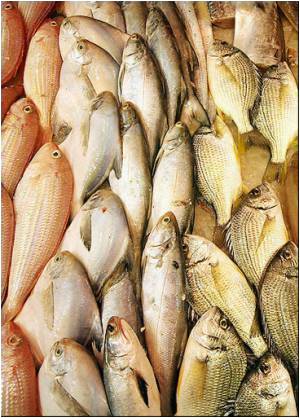Seafood industry people from around the world joined together to find a solution to the problem of feeding the growing appetites with fewer fish.

The United States imports 83 percent of its seafood and the government's publication of new anti-obesity dietary recommendations, including a doubling fish consumption, points toward Americans needing a lot more.
Currently, average seafood consumption the United States reaches only seven kilos (15.4 pounds) a year per person, against 50 kilos (110 pounds) for beef and 35 kilos (77 pounds) for poultry, said Gavin Gibbons, spokesman for the National Fisheries Institute.
"The Japanese consume five to six times as much seafood as we do," Gibbons said. "Doctors and dietitians suggest that Americans should double their consumption and the US secretary of agriculture has recently said that Americans should begin to replace some of their meals with seafood."
The question for those catching, selling and serving the fish, though, is how to make sure that the world's already over-fished seas can actually provide what is needed.
At the start of the three-day Boston trade fair attended by 20,000 people, six industry members were honored for their efforts at promoting sustainability in the supply chain.
Advertisement
"Olivier invited 400 chefs of Relais et Ch�teaux to (fisheries in) Norway to help them understand sustainability," said Jonathan Cartwright, chef at the White Barn Inn in Kennebunkport, Maine, who was accepting the prize on behalf of Roellinger.
Advertisement
Asia, where seafood is already a staple, is seeing environmental destruction on Thailand's coasts, and a fall in shellfish and big fish populations that echo earlier catastrophes in US and European waters.
"When I saw seafood decline in Maryland..., I went to Asia, where I have 17 factories. Then I saw the decline there too, five or six years ago, so I decided to form an association and to draw producers to sustainability," said Steve Phillips, CEO of Phillips Food and Seafood Restaurants Baltimore.
"The most important is getting governments to impose rules and regulations. The minimum size of the crab must be eight-10 cm (three-four inches). The challenge is the enforcement. We need the governments to do that," Phillips said.
Many at the trade fair feel that farming is the only way out. Farmed seafood already accounts for 50 percent of supplies.
Environmentalists say the practice causes its own problems including the introduction of diseases and the need to harvest huge amounts of wild fish in order to feed those held in pens.
Supporters, however, say there are positive trends including fish that turn vegetarian such as the barramundi, a carnivore that can live on a largely vegetarian diet and as a result is seen by some as a champion of the "green" menu.
The next frontier could be genetically modified fish, with companies like Aquabounty waiting for US regulatory approval on its modified salmon which can grow twice as fast as a natural salmon.
Source-AFP











